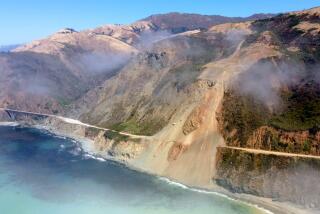Highway Collapses
- Share via
The portions of Interstate 5 and Highway 14 that collapsed where the San Fernando and Santa Clarita valleys meet were scheduled for retrofitting this year. But experts say that because of the quake’s severe vertical movement and the highways’ location near an unknown fault, retrofitting may not have prevented the collapses. Both highways were built to meet standards set after the 1940 El Centro earthquake. Those standards did not require engineers to gauge the danger of nearby fault lines.
The freeways are expected to be repaired within a year. Meanwhile, detours are being opened. The heavily-used I-5 has top priority in the rebuilding process, which is moving at a rapid pace. “We’re doing things within days right now that would usually take us months or even years,” said Jim Roberts, chief engineer at Caltrans.
About the Freeways
Highway 14 (Antelope Valley Freeway)
Built: Parts that recently collapsed were under construction during the 1971 quake.
Average number of vehicles: 127,000 daily at interchange, in both directions
Interstate 5
Built: Section that collapsed was finished in 1967, survived 1971 Sylmar quake with minimal damage.
Average number of vehicles: 191,000 daily in both directions.
Soil Danger
The ground the freeways are built in may have contributed to their collapse. The soil under the interchange has a high clay content, which transmits more of the earthquake’s shocks than oth1701981216 The following sequence of events caused the collapses of each of the four sections of the I-5 overpass at The Old Road, shown at left. 1. Restrainers, which were installed after Sylmar quake, broke. 2. Joints were pulled apart. 3. Spans then collapsed, breaking off on opposite sides. Status: Bridges have been demolished. The Old Road has been rebuilt as a four-lane detour between Weldon Canyon Road and Calgrove Boulevard. The detour is scheduled to open Saturday morning. Reconstruction of the bridge is to begin Monday. Both of the Highway 14 collapses were caused by failure of the short, inflexible columns. The following sequence of events led to the collapses of the Highway 14 connector onto the southbound I-5, shown above. 1. Short-column broke. 2. Adjacent spans were pulled off abutment. 3. Span on other side of abutment could not be supported by remaining column and fell. 4. Status of I-5 / Hwy. 14 interchange: Damaged area was shored up and lanes restriped. Two southbound lanes opened Friday, one a car-pool lane. A. 450-foot section of Hwy. 14 connector to southbound I-5 fell onto I-5. (shown above) B. 300-foot section of southbound Hwy. 14 connector to north I-5 fell adjacent to truck lane. (not shown) Sources: Caltrans, University of California-San Diego; Research by JULIE SHEER and KURT PITZER / Los Angeles Times
More to Read
Sign up for Essential California
The most important California stories and recommendations in your inbox every morning.
You may occasionally receive promotional content from the Los Angeles Times.













